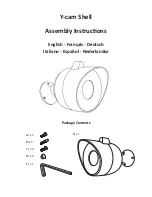
2) This test is only really necessary for those who wish to do advanced aerobatics/3D flying and should
only be carried out those who are confident to do so. With the model at a safe height fly the model
sideways, starting slowly and building up speed until it reaches its maximum possible speed:
a)If the tail manages to hold its position then the blade length is OK.
b)If the tail starts to lag behind, then either more pitch is needed (if the mechanical limits haven't
already been reached) or longer tail blades.
c) If the tail swings round suddenly and cannot return to the correct position then the tail rotor is stalling
and longer tail blades are needed.
Maximising Performance for Advanced 3D/Aerobatic Flight - by Bob Johnston
To get the maximum performance from this or any piezo gyro it is essential to minimise the vibration
reaching the gyro sensor. Apart from the obvious balance checks, make sure that the canopy, fins,
tuned pipe or muffler are not too loosely mounted, especially if the gyro is being used with a fast servo,
as it is possible for a resonance to build up which shows as a very fast shake, visible in the canopy and
tail.
If you feel confident to do so, try slowly tumbling the model while checking for any visible vibration, a
small amount is almost inevitable, but try to dampen any large vibrations present. Alternatively tumble
or roll the model at a safe height and if the gyro can be made to wag through the manoeuvre this is a
good indication that a component is resonating.
To set the maximum gain permissable for aerobatic flight, either a) fly the model as fast as possible in
a straight line and twitch the rudder stick a small amount, if this causes the gyro to wag, lower the gain
and repeat the test until the tail cannot be made to wag anymore. Obviously if the model cannot be
made to wag initially, keep increasing the gain until it does, and then reduce the gain a few percent.
Setting the gyro this way should prove sufficient for all flying except in very windy turbulent conditions
where the gain may have to be lowered by a few percent. b) Alternatively, if you feel confident enough
in your ability and your models reliability, put the model in a vertical dive for 3 or 4 hundred feet (90 to
120 metres) with the main rotor pitch at zero. Once terminal velocity has been reached, pull the model
out in a smooth arc, and if the model does not wag under these conditions it is unlikely to do so under
any conditions.
WARNING: Only attempt to carry out these flight tests if you are 100% confident in your own
flying ability, and the structural integrity of your equipment.
Boom supports
Tests have shown that the use of boom supports significantly increase the rigidity of the tail boom and
so allow a higher gyro gain to be used. Generally the longer the boom supports the better they will work.
Note: A loose/cracked boom support or a loose/cracked boom support clamp can have a significant
effect on the gyro gain.
Temperature stability
Although the gyro is temperature calibrated small temperature differences between the piezo sensor and
the temperature sensor occur from internal heating of the piezo sensor. These may cause a small trim
change during the first two minutes of operation. It is best to avoid flying the model immediately after
exposure to sudden temperature changes such as removing it from a cool car to a very hot flying site.
Humidity
Under conditions of extremely high humidity it is possible for condensation to form on the piezo sensor.
Formation and evaporation of this condensation will cause a shift in the gyro trim. Where it is not
possible to avoid subjecting to the gyro to such humidity levels it is advisable to leave the model
standing for a few minutes with the radio switched on so that the internal heating of the sensor disperses
the condensation. Having done so, cycle the receiver power to reset the gyro. Always protect the gyro
from ingress of water (e.g. rain).
PC interfacing
Your ICG360 is equipped with a 'COMPUTER' port which is provided for the experienced pilot wishing to
optimise the internal settings of the ICG360's two flight modes to their helicopter and flying style. An
optional Interface cable and software disk is available for use with this port. The interface/software is
compatible with any IBM PC compatible with a parallel (printer) port and VGA graphics. Comprehensive
additional instructions on the use of the PC interface are supplied with the software. Connection to the
'COMPUTER' port of the ICG360 must only be made via the correct optional interface cable.
No other form of connection to this port should be made as mis-use of this facility may damage the gyro
unit.


























